Hard Pruning Tree Wisteria
I need some advice about hard pruning from the knowledgeable folks here.
I have a 20 year old Chinese tree wisteria which has become over-grown, so it needs some serious pruning. It's about 5 feet tall but it's more like 7 - 8 feet across. The trunk is about 5 - 6" in diameter.
I would like to top it down to about 4 feet & reduce the diameter to about 5 feet. In searching the web & this forum, most of the pruning information I've found is based on vines or minor pruning of tree wisterias. In the past, I've pruned this one annually but rarely more than 6 inches off the end of a branch.
How much can one cut off of a branch? What time of the year is best to do this kind of pruning? Normally I prune just after it's done blooming.
Best regards, Richard
Comments (37)
woodyoak zone 5 southern Ont., Canada
12 years agolast modified: 9 years agoIt's much easier to do shaping pruning in the early spring while it's stil dormant and the branches are bare so you can see what you're doing! You can also see where the flowerbuds are so you can prune to retain maximum buds/flowering wood in the area where you want to cut it back. We cut ours back a bit harder than usual this spring to reduce the width and make more space for things underneath it. It didn't mind a bit!
rckowal
Original Author12 years agolast modified: 9 years agoThanks for replying Woodyoaks.
Although pruning back only enough to conserve flowering wood/buds in the spring is a good idea, I doubt that I could reduce the diameter more than a foot. To get the diameter down to where I want it will probably require pruning off many branches that have the current flowering wood/buds.
Maybe I'm wrong, but it seems to me that if I were to prune during this summer, the flowering wood might some what regenerate itself in time for next springs bloom. But I've never done this so I'm hoping for comments whether this will work or not. Said another way, if I were to prune off most of the flowering wood at this time, what should I expect to see next spring? No blooms? Some? Long wait until it regrows flowering wood??
Richard
Related Professionals
Essex Landscape Architects & Landscape Designers · Tomball Landscape Architects & Landscape Designers · Berkley Landscape Contractors · Bound Brook Landscape Contractors · Edinburg Landscape Contractors · Flagstaff Landscape Contractors · Fort Worth Landscape Contractors · Middletown Landscape Contractors · Oak Forest Landscape Contractors · Yukon Landscape Contractors · Golden Valley Landscape Contractors · Boston Roofing & Gutters · Columbus Roofing & Gutters · Golden Valley Roofing & Gutters · Saratoga Springs Siding & Exteriorswoodyoak zone 5 southern Ont., Canada
12 years agolast modified: 9 years agoIf you have a Chinese wisteria, there is likely flowering wood all through the tree, not just on the outer bits. That's certainly the case with mine. I could probably cut mine back to within a foot or so of the main trunk and still have flowers that spring!
Can you post a picture of yours? I'd love to see it....
rckowal
Original Author12 years agolast modified: 9 years agoInteresting! But I'm only guessing that my wisteria tree is a Chinese since it blooms early in May (S.E. Michigan). I think the Japanese bloom later; additionally from what I've seen on the web, it appears that the petals on the blooms are multi-colored. Do you know if there is a way to determine if mine is truly Chinese?
I'll post a picture of mine a bit later but for now, I thought you might be interested in the wisteria video link found on Youtube.
Here is a link that might be useful: Wisteria Videos
woodyoak zone 5 southern Ont., Canada
12 years agolast modified: 9 years agoThe easiest way to tell the difference is the Chinese wisteria twines counter-clockwise and the Japanese wisteria twines clockwise. (American wisteria twine counter-clockwise.)
Chinese wisteria twining counter-clockwise:
{{gwi:193460}}
(Stem rises from lower left to upper right...)Japanese wisteria twining clockwise:

(stems rise from lower right to upper left...)So, if you look at the stem twining direction it's easy to tell Chinese and Japanese wisterias apart. The Chinese ones start blooming before the leaves emerge while the American ones bloom after the leaves emerge. So, although both Chinese and American ones twine in the same direction, it should be easy to tell which one of those two you have by the bloom habit. Also, the scent of American ones is usually described as 'musk' and is often considered as unpleasant while the Chinese ones' scent is very pleasant.
rckowal
Original Author12 years agolast modified: 9 years agoThanks for the pics. - they really help.
Mine blooms before it leafs out & the fragrance is very pleasant so it must be the Chinese. However, it is not twined around a supporting mast like yours; it has a true, tree like, trunk. I believe mine was probably grafted on to some sort of woody tree stock.
I'll soon post the pics of it from 5 years ago in full bloom as well as now. I just need to figure out how to embed or link them on this forum.
woodyoak zone 5 southern Ont., Canada
12 years agolast modified: 9 years agoWhat miy Chinese wisteria is twining around in that picture is itself! The smaller stem is twining around the larger main trunk :-) The Japanese one is twining around a stake to get it started (it's only 5 years old and hasn't bloomed yet.) Eventually all those stems should merge to to form an interesting trunk. It is common to use a stake to start them. An article a while ago in the Royal Horticultural Society's Garden magazine warned that most Victorian-era wisterias have an iron stake in the center of their trunks (i.e. be very careful trying to cut one down!)
Most named cultivars are grafted onto rootstock - often the rootstock is a Japanese wisteria (because Japanese wisterias produce more seeds than the Chinese ones do.) Rootstocks are usually seedling plants - which is why you need to remove root suckers. The root suckers are most likely to be an inferior plant that may not bloom - or bloom diferently than the named cultivar and is apt to be a totally different species of plant! It is usual to graft stems that come from a plant that has already flowered onto the seedling rootstock. That way, the wait for the vine to be mature enough to flower is shorter. Sometimes the vine is started from a rooted cutting. If it's grafted, the graft union should be obvious. My Chinese one is grafted - the graft union is a bulging area near the base. Any growth from below that point definitely needs removing.
If you seach on GW, you will find lots of threads about how to post photos. You need to have the photo on a photo-hosting site of some sort and then copy the appropriate tag line into the post here. If the photo shows when you preview your post, you're fine; if it doesn't you've used the wrong tag line, so try another option (most photo sites show several options...)
rckowal
Original Author12 years agolast modified: 9 years agoI could use a bit of help with posting my photos. I've done this type of thing on eBay & other forums many times but can't get it on this one.
I have them uploaded to a photo hosting service (Image Shack), I've read & followed directions found on G.W.; copied & pasted the link OK, but can't get them to show up in my message draft. When I try to Preview, I keep getting the following error message.
"Message Rejected. You must provide a name, email address, subject and a message. Please make corrections below:"!
What am I missing?
rckowal
Original Author12 years agolast modified: 9 years agoI had it OK but had to break the link due to unforeseen security reasons. Will fix that & re-post later.
rckowal
Original Author12 years agolast modified: 9 years agoMy wisteria tree pics: Trunk 2011; In bloom May 4, 2006; Aug. 2011.
{{gwi:738745}}



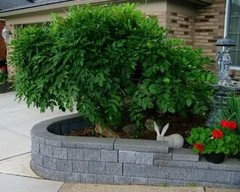
woodyoak zone 5 southern Ont., Canada
12 years agolast modified: 9 years agoNice looking wisteria! You are obviously way more disciplined in pruning than we are. We go for a bigger, more chaotic presence :-) It doesn't look to me like it needs a lot of cutting back. The shape nicely fits the shape of the raised bed. If you wanted to cut it back, I'm guessing that you'd want to cut back the thinner stems at the narrow end of the bed and maybe a bit off the stems closes to the house...?
Depending on whether you always want to keep it smaller than it is at the moment or let it regrow to the same size, you could either trim back those thinner stems at the end or cut back the thicker, more horizonat branch that they arise from. That would still leave a nicely shaped but smaller tree. And you'd still have all the structure to the left blooming as it is in the second picture. If you want to cut the house side back, definitely wait until spring. While it is still dormant, you will be able to easily see the fat flower buds so you can judge where to cut and still have flowers on those branches - i.e. shorten but don't remove completely on the house side.
rckowal
Original Author12 years agolast modified: 9 years agoThanks. Regarding my pruning, I don't think it's discipline as much as it is necessity. Although I try to keep the gardens & growth looking neat, there are other reasons to keep the wisteria under tighter control.
It really isn't obvious from the latest pictures that it's already starting to grow out beyond the garden wall, over to the house & fountain as well. The longest lateral branches appear to grow at the rate of about 8"/year. Numerically, that may not sound like much but that's more than enough to interfere with people on the walk going up to the front door.
Regardless, if it didn't severely disrupt blooming, I would like to prune the laterals back by about a foot or a bit more all the way around. Maybe I'm wrong but this would mean cutting off the "hands" where (I believe) a lot of the bloom buds originate. Frankly, I'm just not too clear about where the recurring blooming bud growth is located - at the "hands" or from new growth. Please help me to better understand this matter.
Best
woodyoak zone 5 southern Ont., Canada
12 years agolast modified: 9 years agoThe 'hands' are definitely a place where blooming happens - and for new vines, having them appear is a sure sign that the vine is getting mature enough to bloom. But a mature, blooming vine has flowerbuds all along the branches. Pay attention early next spring to the appearance of the buds on the stems - you can also see it (but less clearly) in the fall when the leaves drop. Dormant flowerbuds are fat while dormant leaf buds are skinny. So looking at the dormant buds on the branches will give you a good idea of how many flowers you'll get after you cut a branch back. I just looked through my pictures to see if I could find any closeups of the bare branches. This one isn't great but you can see the fat buds all along the branches - those are dormant flowerbuds.
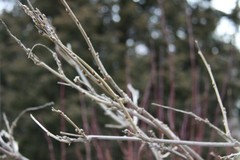
rckowal
Original Author12 years agolast modified: 9 years agoThanks for the picture of the buds & related information. This is helping me a great deal to comprehend the nature of wisterias.
Although I've seen them in the spring, I never really grasped the difference between the flowering and the leaf buds - until now.
But I'm still vague on some aspects of pruning to reduce size. In your explanation & picture, what you referred to as branches appear to me to be more like twigs. Maybe I'm wrong, but aren't they the pencil sized wood that grows out from a hand at a large primary branch that grows out of the trunk?
As mentioned earlier, to reduce the diameter on mine, I will have to go inboard of the twigs & hands to actually prune off part of the big primary branches. I don't recall ever seeing any flowering buds on those big branches so I can't visualize what will happen if I prune back that far. Will new hands grow out of the end of that primary branch - which will eventually form blooming buds?
If it will help, I can post current pictures of the wood as it exists at this time. I even can mark the branch with a piece of tape where I would like to prune it.
Please bear with me. I apologize for being so slow in trying to understand this subject.
Best
woodyoak zone 5 southern Ont., Canada
12 years agolast modified: 9 years agoNo problems... I got hooked on wisterias during a visit to England in May 25+ years ago :-) I've been reading about them and growing them ever since. Even so, I'm still learning! We only planted our first Japanese one five years ago - it hasn't bloomed yet. (They have a reputation of taking longer to bloom...) There are noticeable differences in how it has developed in comparison to the Chinese one.
I should point out that, when the vine is young and hasn't yet flowered, the fat buds can, frustratingly, turn out to be leaf buds! But once it is mature enough to be reliably blooming, you can trust the fat buds to be flowering ones. My Japanese wisteria for the past two years has been at the frustrating stage where it has flowering spurs formed, has fat buds, including fat terminal buds on the flowering spurs, but no flowers are produced. Maybe next year...
The only difference between some of those skinny branches and the thicker older wood is time! In the picture above when I was talking about counter-clockwise twining, you referred to the 'mast' that the stem was twining around... That 'mast' ten years ago was a skinny little branch.
If you cut off some of the oldest wood, new stems will sprout along any remaining piece and the flowering wood and buds will develop on those. Here are two more pictures of the bare branches of our Chinese one from March 2010. You can see the variety of thicknesses of the wood depending on how old the particular stem is. This picture is near the top of the tree so the wood is younger there:
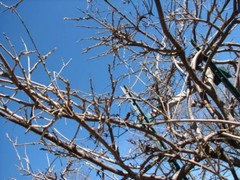
This one shows DH doing a bit of thinning out. Because we want the tree to be a large screening shrub-like structure, we keep it 8-10' tall and fairly wide.
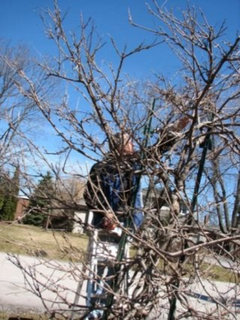
The Chinese wisteria is the large green shrub/tree to the right of the end of the driveway:

The Japanese wisteria is on the far right of the same bed as the Chinese one is in, just outside the range of this picture. Usually there would be lots of summer flowers on the Chinese wisteria but this year there have been hardly any. I assume the drought has been responsible for that! We had less that 1/2" of rain in all of July; normally we have over 3".I printed your picture of the vine in flower and marked where I would prune it to make it smaller while still keeping a nice shape and lots of flowers. I'm not sure if this picture is clear enough for you to see the lines I drew to indicate where I'd cut. Basically, from what I can see in the picture, I'd cut back the two, older, horizontal branches on either side of the base. It looks like if you did that, you'd have a nicely shaped narrower tree with lots of flowers at the top. Do you have any pictures of it before it flowered - so you can see all the structure more clearly?
{{gwi:738759}}rckowal
Original Author12 years agolast modified: 9 years agoThanks again. This is really great stuff. With your knowledge of them, you should write a book on wisterias - I'll be you first customer.
Actually, I already pruned off the older bottom branch seen on the right in your post, last year. I also have an eye on the other one for this fall.
Unfortunately, I don't have any pictures of mine before it flowered. I could however, spread the branches apart so I can photograph some of the inner branch structure. It's not the best, but it might help to facilitate the discussion.
Although the Mrs. & I have visited & toured about with our friends in England, I don't recall seeing any wisteria while we were there. We did however, see some really unique ones that lined a fence at a Palace in Warsaw Poland. They had yellow blooms & were about 15 - 20 feet tall.
Additionally, there was an older Italian gentleman in the neighborhood who had a really big Chinese vine. It was draped over a room sized pergola on the patio behind his home. It was an experience to be inside of that terrace when it was in bloom - the scent made you feel like you had died & gone to heaven.
woodyoak zone 5 southern Ont., Canada
12 years agolast modified: 9 years agoI don't know nearly enough to write a book on them!
There are no yellow wisterias. What you saw was probably a laburnum. There are a number of well known laburnum tunnels/walks that are very striking - try doing a Google image search on laburnum walk and see if that was what you saw. The one in this pcture belongs to a neighbour:
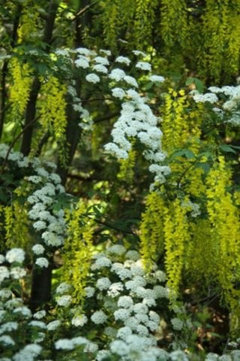
If you didn't see wisterias in England, you weren't paying attention! :-) Go in May when they are in bloom and you will see lots of them. They seem to be most commonly grown up walls on houses or over brick or stone garden walls. There's a beautiful white one at Sissighurst growing over/along a brick wall.
If you pruned off the bottom branch on the right already, I think pruning off the one on the left would fix the size issue as well as leaving you with a nice shaped tree.
rckowal
Original Author12 years agolast modified: 9 years agoI stand corrected about what I thought was a yellow wisteria. I have a camcorder video of them so I took another look & compared it to laburnum found on a Google search. Although the video clip was from a distance, so the nature of the blooms couldn't be seen, it sure looks like a laburnum.
It just dawned on me that I probably didn't notice any wisteria in England because we were there in August & they weren't in bloom.
I'm still unclear about what would happen if I were to prune off about a foot or so of the younger growth at the end of an old branch, leaving a 2' long section of old wood. Do you know if new wood growth & foilage will emerge at that pruned end?
Best
woodyoak zone 5 southern Ont., Canada
12 years agolast modified: 9 years agoA lot of people assume laburnum is wisteria. They are both legumes so the flower racemes do indeed look similar.
If you cut back the wisteria so that you only have old wood, new growth will appear but most of it will arise along the length of the old stem rather than from the end. If you are looking at shortening the younger growth rising from the thick older growth, you'd likely want to preserve some of the flowering on that growth - right? (i.e. are you thinking of reducing the height of the flowering stems so the tree is shorter?) If so, it would be best to leave the pruning of that part until next spring so you can see the fat flowerbuds and decide how many you're willing to sacrifice. So you could prune in a two-step process - take out the stem on the left near the base now and next spring shorten the younger upright stems. You will have fewer flowers but would still have a nice display as long as you pay attention to how many flowerbuds you're leaving when you chose where to prune the stems back to.
rckowal
Original Author12 years agolast modified: 9 years agoOK, now I understand the effects of pruning both older as well as younger wood. Thanks for clearing that up for me. I've done a lot of searching but have never seen that explained before.
Being a retired Engineer, I love to experiment on a small scale to actually see the practical effects of doing some thing before jumping into a wholesale action. Additionally, it's essential in the case of our wisteria since my wife would kill me if I "hurt it" (grin).
Unless you tell me there is a better time to do so, I think I'll prune back (rather than off) the old unwanted branch right now. Then I can observe the effect of the new growth emerging from the old before next Spring. I don't doubt what you say, but this sounds like like an interesting as well as educational project for me.
Best
woodyoak zone 5 southern Ont., Canada
12 years agolast modified: 9 years agoThat sounds like the right thing to do. You may find that pruning off will look better than pruning back in terms of the look of the tree. Leaving a stub sticking out of the side of the trunk might not look good - but you can always prune it again if it doesn't look right after the first cut. Wisteria grows so fast that 'mistakes' are soon erased with new growth :-)
rckowal
Original Author12 years agolast modified: 9 years agoTo launch the experiment, I just pruned beck about 10" of an old wood branch. I also plan to prune back a second one pretty much the same way. Then I'll sit back & observe. Providing that I don't forget, I'll let you know how it turned out. Unfortunately this is not an opportune time to photograph before/after or I would do that too.
If you don't mind me asking, in what part of Canada do you live? I'm just across the river from Windsor. Actually, some of the garden stock sold in nurseries around here is grown there. When I was still working, I traveled on business in Ontario for more than 25 years. While there, I frequently took time to visit some of the botanical gardens & nurseries.
Best
woodyoak zone 5 southern Ont., Canada
12 years agolast modified: 9 years agoIt'll be interesting to hear how your experiment goes...
If you've ever been to RBG (Royal Botanical Gardens), you were 20-25 minutes away from where we are. There are lots of good nurseries around here, but you wouldn't have been able to take the plants back across the border, would you?
rckowal
Original Author12 years agolast modified: 9 years agoI know the Hamilton/Burlington area fairly well but when I was there on business, I was just too busy to take time off to visit the RBG. My company had a good customer in Burlington - who coincidentally also had an operation here in the States not far from where I live. I used to do some new product development work with them.
We some times spend a few hours at the Jackson Gardens in Windsor. The rose garden there is huge & very impressive. They also have a some very nice perennial & annual gardens. Before the world got complicated, we used to walk our two chihuahuas there.
Although I've never done it, I understand that so long as a live plant was actually grown in Canada, it can be imported to the States. Some years ago, when there were Canadian peach orchards near us, I used to bring some home. We still occasionally shop for specialty groceries in Windsor & never had a problem crossing the border - so long as there is no fresh or processed beef involved (mad cow disease precaution).
Best
soxxxx
12 years agolast modified: 9 years agoI love wisteria to see and to smell, but I will enjoy it in someone else's garden, I shovel pruned (no chain sawed) mine last year.
It was one of the most labor intensive plants that I ever planted. Every week there were several 3 - 4 foot long runners at the base to be removed.
It is still trying to sprout around the stump in spite of receiving no water for months.
kathy925
10 years agolast modified: 9 years agoMy husband cut our wisteria back very severely late this winter (without my knowledge or approval!) and I'm afraid he killed it. We have two plants, one on each side of our pergola and met in the middle...about 30' span. He cut each plant back to just the main trunk with three to four branches about 4' long. It's now early May (although a very late spring in Southern Illinois) and there is no sign of any growth. We thought the plants were dead, but when we cut a piece off an end, it does still look slightly green inside. Does anyone have any input on when we should give up and cut them down? I don't know if they're Chinese or American. I read here that both of these twist counterclockwise, like mine. Any input would be appreciated.
preese1
9 years agoI have a similar problem, but very old plant trunk is about 18 inch diameter. I think it is at least 80 yrs as my house was built in 1005. Plant weight is collapsing the wood arbor that is supporting it. Growth of vine is about 25 ft. Must cut back to rebuild. Neighbor says chainsaw. I don't know what to do or when to do it
woodyoak zone 5 southern Ont., Canada
9 years agopreese1 - that sounds like a pretty impressive plant! If it is still productive and blooming, wait until after it blooms this spring, then cut it back as hard as needed. I'd likely preserve the main trunk and just cut back the upper branches at arbour height. They should then put out lots of new growth and be ready to flower again the following year. Now that the Chinese wisteria here is as tall as we want it to get ~8-10') we cut it back 12-18" every other year to control the size. We're keeping the Japanese one shorter - 6' or so. The brutal winter of 2013/2014 killed all the flowerbuds on both. This winter has been almost as bad here so I'm unhappily assuming no flowers again this year, but it's too soon to tell for sure.
alameda/zone 8/East Texas
9 years agoI have several wisteria bushes. The whites are just now getting old enough to bloom. Though they bloom beautifully, I am wondering if I need to fertilize them. Can anyone advise me on the proper fertilizer to use on wisterias? And when and how many times should I fertilize during the year?
Thanks.......Judith
woodyoak zone 5 southern Ont., Canada
9 years agoI was sure I replied to this last week, but I don't see it....
Wisterias are members of the legume family so they 'fix their own nitrogen. If a soil test shows your soil is deficient in other nutrients, you could add those, but you won't need nitrogen. Wisterias are quite capable of producing profuse vegetative growth without making it worse by adding supplemental nitrogen! I have never fertilized my wisterias and they do just fine.... (The following picture is from 2013 as all the flowerbuds winter-killed in 2014 - and I fear for them after this winter too....!)
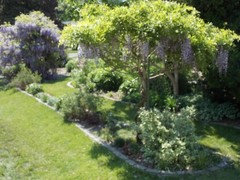
Tina Buell (Z9b)
8 years agoI found a picture of @rckowal's wisteria online, not sure if someone stole his picture without his permission, but wanted to share it: https://www.etsy.com/listing/198518709/50-chinese-wisteria-seeds-wisteria?ref=market
Daniela Sgro
5 years agoHelppppp please
I have a 2 year old Chinese wisteria and just got home and have found the wind has completly blown down my trellis.
all the plant has broken off the trellis so I need to start all over again and buy new trellis.
can I cut back wisteria to only the trunk and start all over again?
its only 2 years old but have managed to trail about 10 feet both ways.
im very devastated as I've taken lots of care and persistance to train.
any help would be appreciated .
thanks
alameda/zone 8/East Texas
5 years agoWisteria is very resiliant. Cut it back to where you need to, replace your trellis and it will be growing again in no time. I have 2 huge mounds of wisteria in my front yard - am going to prune them back hard to cut down on the size. They will bloom in spring like before. Wisteria is a very tough plant!
Judith
NHBabs z4b-5a NH
5 years agoMake sure your trellis is stout and strong. If it blew over at 2 years, it wasn’t strong enough. If wood, 6”x6” timbers minimum, and larger is better. If metal, think heavy duty iron pipe or similar. These are large, heavy plants.


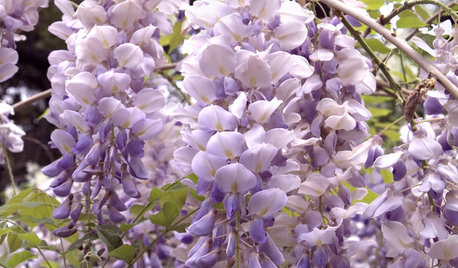

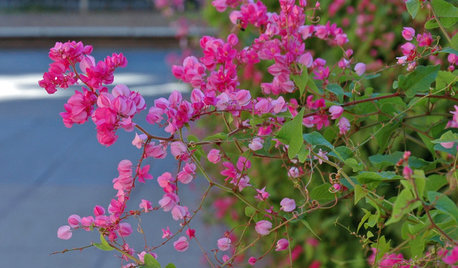


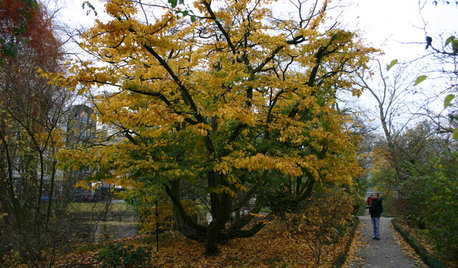
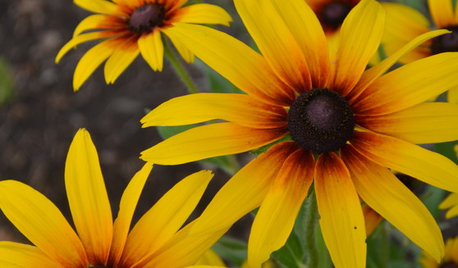







gdpossehl